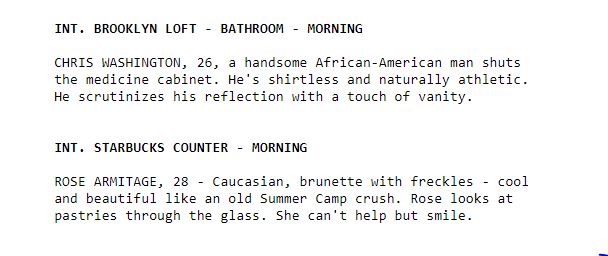
the sexy “my gaze shifted”) but I think it’s more authentic. Sure, it’s probably less fancy to adhere to true first person tone when describing physical events (the boring “I glanced” vs. This note about character description in first person is more subtle, but I’ve found myself giving it a lot lately. Writing a Character Description That Sounds Natural That same tone doesn’t work when you’re writing character description in first person, when the protagonist is talking about their own body. Sure, we can’t see his muscles tighten or his heartbeat quicken from a true bird-eye view, but the tone of this piece is that of an outside observer.

Character descriptions screenplay examples how to#
Now, it’s not a perfect paragraph, and it still has a lot of no-nos in terms of how to describe emotion, but it sounds much more natural in third to my ear because we’re observing the character from the outside. With his breath coming in short, shallow gasps, Jake prepared himself to attack. He leaned back against the wall, the muscles in his torso tightening, his mouth drying out, his legs ready to spring into action. Jake’s heartbeat quickened and his pupils contracted with fear. His gaze shifted to the corner of the room. To further illustrate the differences when you’re writing a character description, let’s put the above passage in the third person: “To my shock” or “shockingly” would be more first person-appropriate. If I were telling a story to a group of friends at a party, I would say something like “I looked and saw” or, if I’m feeling really fancy, “I glanced over.” When I’m writing character description in first person, it feels oddly distancing to say, about myself, “my gaze shifted.” I also wouldn’t say “my mouth dropped open.” I’m not watching myself on a video tape and narrating what’s happening. When you’re writing a character description about yourself, do you say, “My gaze shifted to the corner and my mouth dropped open to discover Uncle Eddie wearing a party hat”? You’ve got them wrapped around your finger as you’re describing a scene, say, the last time you were thrown a surprise party. Imagine you’re telling an anecdote to your friends. I fear I’m not making a whole lot of sense, so I will try another approach. This most often happens with physical descriptions/actions. Passages like the one I’ve written above are first person character description (within the body) but seem oddly outside of it. When you’re in third person, even if you’re in very close third, you’re on the outside of the body, seeing it from a bit of a bird-eye view. When you’re writing in the first person, you are immediately inside your character’s head, heart, and body. Can you figure out, from this sample, what I might mean? I’m referring to a style of narration that is more commonplace (and appropriate) when writing a character description in the third person.

Now, this is a subtle one to pick up on, I think. With my breath coming in short, shallow gasps, I prepared myself to attack. I leaned back against the wall, the muscles in my torso tightening, my mouth drying out, my legs ready to spring into action. My heartbeat quickened and my pupils contracted with fear. My gaze shifted to the corner of the room. What to Avoid With Character Description in First PersonĬharacter description in first person POV (and what to avoid) is easier to illustrate than to explain. How does your protagonist describe him or herself? Don’t fall into this common trap when you’re writing a character description. What’s a great way to accomplish character description in first person POV? I want to talk about something I’ve been noticing a lot: third person-style narration in the first person.


 0 kommentar(er)
0 kommentar(er)
